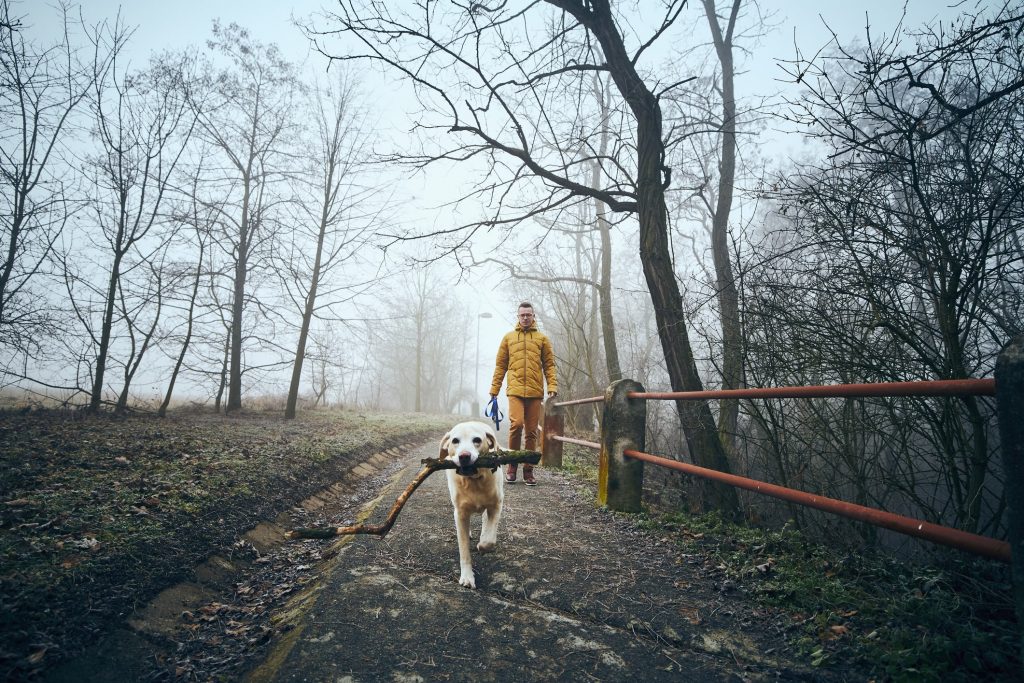- This post contains affiliate links. Read more here.
- Not a substitute for professional veterinary help.
We know seasonal changes can influence the human disposition—a condition called Seasonal Affective Disorder (SAD). Winter’s shorter days decrease our exposure to sunlight for long periods. This can alter the brain’s chemistry, causing increases in melatonin production and decreases in the production of serotonin, the compound that improves mood and social function.
Those who struggle with Seasonal Affective Disorder can experience a variety of symptoms, including loss of appetite, low energy, and a general sadness that persists until the days lengthen again in the spring. Since there are similarities between dog and human brains, it’s reasonable to wonder whether the winter doldrums also affect our pets.
Observed Behavioral Changes During Winter Months
iStock via Chalabala
One survey in the U.K. found that one in three pet owners noticed changes in their pets’ behavior during winter months. Some of these included:
- More frequent barking
- Increases in aggression and destructive behavior
- Decreases in playfulness
- More time spent sleeping
- Weight loss or reduced appetite
- Increased shedding or loss of fur
While it stands to reason that dogs could be similarly affected by the seasons, it’s important to note that the survey conducted in the U.K. only measured dog owners’ perceptions, and was not a scientific study. As PetMD notes, “there is not enough data to support a definitive diagnosis of SAD in pets.”
Other Possible Explanations for Symptoms of SAD in Dogs

DeborahMaxemow via iStock
There may be other reasons why dogs appear to feel “meh” during cold, dark months. For one, we know that dogs often mirror their owners’ behaviors and moods. Dogs’ emotional capacity enables them to intuit or recognize certain human behaviors and respond in kind.
For example, a dog living with a human experiencing Seasonal Affective Disorder will notice a shift in the owners’ behavior to a more sedentary and low-energy lifestyle. The dog can pick up on the quiet or depressed feeling in the home, and begin to embody that same disposition as a way of adapting to his environment. And because of dogs’ attachment to their owners, they’re likely to stay close by, joining in whatever the human is doing, whether running around or lying low.
But the winter months may make it more difficult to get outside for exercise and play. The resulting accumulation of “inside time” may simply lead to boredom. Dogs thrive on physical activity, play, and smelling all the smells outside. When they’re deprived of this stimulation, they’re likely to feel bored, which can look a lot like depression.
How to Help Your Dog Through the Winter Blahs

iStock via Chalabala
Whether or not dogs technically suffer from Seasonal Affective Disorder, there are things you can do to keep your dog happier and brighter if you notice her mood lagging in the winter.
- Fight the urge to hibernate, and get outside with your pet as much as possible, even if the weather isn’t ideal. The physical activity and exposure to sunlight (however dim) will help alleviate mood slumps.
- Try to increase light exposure as much as possible. Move your dog’s bed closer to the window that receives the most light during the day. Try to get outdoors for a walk (even a short walk) during the brightest part of the day. Or consider introducing artificial light into your home. Light boxes provide a substitute for the waning light during winter months, and can help return melatonin and serotonin to normal levels.
- Create playtime indoors. You definitely want to spend the bulk of your dog toy budget during winter, especially if you live in a cold climate! Invest in a few interactive puzzle toys or brain teasers, like this one, for your pet. Don’t just leave the toys lying around the house, but get down on the floor with your dog, play a little tug-of-war or fetch down the hallway. This mental stimulation and the interactive play will not only strengthen the bond between you and your pet but also stave off boredom and gloominess for both of you!
- Be careful with supplements. Humans experiencing Seasonal Affective Disorder are encouraged to take vitamin D, but this is not recommended for dogs. Too much vitamin D can be toxic to dogs, and most store-bought dog food provides sufficient vitamin D. Omega-3 fatty acids like fish oil, however, can help improve a dog’s cognitive function. But check with your veterinarian before adding this to your dog’s diet.
While we can’t say for sure that dogs are susceptible to Seasonal Affective Disorder, we know some owners see mood changes in their dogs during wintertime. Winter makes a lot of us want to hole up, stay warm, binge TV, and snuggle. But keep an eye out for changes if your dog shows any of the symptoms described here, and make an extra effort to keep your pet active, engaged, and having fun.

